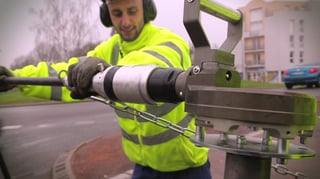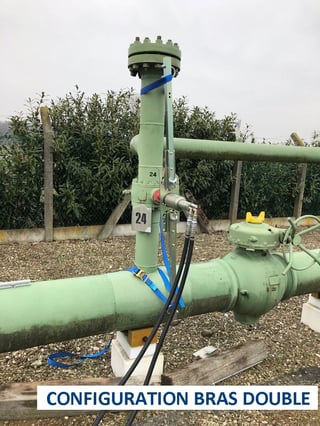Portable actuators are used to help carry out many different tasks, in many sectors and industries. In particular, they are used to open all types of valves/stopcocks or hand-wheels that are either motorless or the motor cannot be used (breakdown, maintenance) and therefore need to be opened manually by an operator. The portable valve actuator helps with this function and is indispensable to the safety of your personnel and equipment.
They are especially useful for the following applications:
 #Isolation valves found in drinking water distribution networks
#Isolation valves found in drinking water distribution networksMost water distribution pipelines are located in urban areas – operators and hydrant experts work in heavy traffic zones to manoeuvre valves buried under the roads, which exposes them to all the dangers these conditions imply. With the portable valve actuator together with an adaptor that fixes directly on to the fountain key, it is much easier to open the valves in safe conditions, while also controlling the speed and torque level to avoid water hammer effect.
Extracting, storing, transporting and transforming petrol or gas, on offshore platforms or on land, demands a comprehensive, complex network of pipes, reservoirs and valves – very often located in a sensitive environment (inflammable or even explosive). Sometimes, the manual valves can be difficult to open. As a result, operators can suffer injury when exerting excessive force to turn the valves. The portable valve actuator is the ideal solution in this situation. With this rotation assistance tool, you can actuate all types of valve or hand-wheel. Plus it’s ATEX certified, so it can be used without danger.

Whether nuclear, renewable energies, fossil, gas or geothermic, the energy production industry is a sector where you’ll find many, many valves or hand-wheels, in particular in vapour pipeline networks. In these very often sensitive environments (risk of explosion, electromagnetic disturbances, humidity, heat etc), the portable pneumatic actuator is an excellent choice. ATEX certified, it doesn’t overheat because the more it turns, the more it is cooled by the compressed air travelling through it. Furthermore, with this tool you can turn hand-wheels without touching them directly.
Portable actuators are useful in any industry where you are likely to find valves and hand-wheels, that’s to say in almost any so-called processing industry such as refineries, petrochemical, chemical, pharmaceutical and food industries etc. In fact, anything that involves transporting fluids. With the simple, unique portable actuator, you can motorise and manoeuvre various types of valves and hand-wheels – which means greater performance for less cost!
Facilities that treat drinking water, filter water or desalinate sea water, and any pumping stations, all use valves to regulate pressure and outflow, block water streams, and to protect the pumps and pipelines. There are large numbers of valves and stopcocks in these industries. It can be much easier to manage such a vast network of valves using specialised rotation assistance tools, such as a portable actuator. They also help you to protect your facilities and equipment, and to reduce risk of injury to staff.

Another sector where you find large numbers of valves and stopcocks is in the transport and distribution of gas. Vent valves are an example here – this process involves directing gas fumes, given off during the production, treatment, transport or storing of gas, to a particular device to be dispersed into the atmosphere. This is done via a valve opening and closing system. With a portable actuator, you effectively motorise these valves which means you can actuate them, even from a distance, in total safety. In this industry, you are better opting for a pneumatic actuator because you’re working in an ATEX environment which carries a risk of explosion.
#Irrigation canal management
Irrigation and flood management networks can be very complex and extensive, circulating by definition in places located far from an energy source. Here, it’s not a question of closed pipes controlled by valves and stopcocks, but rather open channels regulated by coffer dams or equivalent, with manual opening and closing systems. The operator has to go out to the site (sometimes located in very remote areas not accessible by car) and manually turn the hand-wheels or cranks. These are often very difficult to activate because of corrosion from exposure to harsh weather conditions. Using a battery-operated or petrol portable valve actuator, this task can be quickly and easily carried out without the need to transport heavy or cumbersome machinery to the site.
 #Transport
#TransportThe transport industry is a special case. Generally, there aren’t many pipes or valves, instead you’ve got numerous manual rotating systems for rolling out covers, lowering tail lifts, operating tipping devices etc. Moreover this sector is always facing a great deal of uncertainty – fluctuating petrol prices, international competition, motorway toll increases, changes to employee protection rules… Faced with these difficulties, transport companies are always looking for ways to reduce petrol consumption (therefore minimising weight) and to optimise driver time management. The portable actuator is a simple, effective tool that helps drivers to save precious time when manipulating rotating systems. What’s more, it’s light and multi-functional so it doesn’t add weight to the vehicle.
Large numbers of pipes and tubes criss-cross the body of a ship, with all the valves that go with them – often manual valves, in confined spaces that are difficult to access. Add to this maritime conditions, which really test the resilience of electric networks and necessitate using extremely robust materials. For these reasons, many of the valves are manual which, as we know, does not make the job any easier for operators. A ship will have a compressed air supply, so it makes sense to use this to feed a portable pneumatic actuator which is light, robust and powerful and, more importantly, greatly facilitates the operator’s task.

+ 33 (0) 4 75 40 27 15
sales@modec.fr
ZI Sirius Quatre
80, allée René Higonnet
26760 Beaumont-lès-Valence, FRANCE
185 Alewife Brook Parkway
#210
Cambridge, MA 02138, USA
11111 Katy Freeway suite
#910
Houston, TX 77079, USA
© Alle Rechte vorbehalten - modec - Verwirklichung : ARKOD